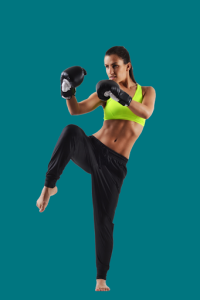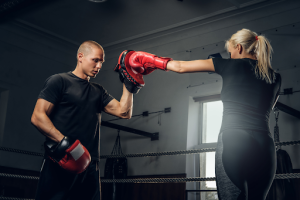By Shotokan Karate Leadership School in Santa Rosa, CA
Shotokan Karate Leadership School knows the physical aspects of karate and how it makes an effective way to exercise the whole body — muscles, coordination, and aerobics.
Karate is a physical endeavor. Students can expect to receive an intense physical workout, benefiting their strength, balance, and cardiovascular systems. This workout makes karate a great fitness activity to include in a personal physical fitness and exercise routine.
Physical Elements of a Typical Karate Class
Depending on the level of the class and the instructor’s preference or schedule, each class session may incorporate the following elements:
- warm-up/stretching
- stances (front stance, middle stance, ready stance, back stance, etc.)
- basics (practicing blocks, strikes, kicks, and other basic moves up and down the floor)
- forms (repeating form segments multiple times)
- sparring (intense bouts)
- one-steps (similar to mini-forms and sparring, with a partner)
- self-defense techniques
For higher belt ranks, classes may also include weapons training, advanced kicks, and various other advanced karate moves.
These various parts of a karate class strengthen students’ muscles, improve their balance and coordination, extend their endurance, and improve their cardiovascular health. For more information on Shotokan Karate Leadership School please visit us at http://askaboutkarate.com.
Practicing with Shotokan Karate Leadership School Builds Muscle and Strength

Karate Stances – from front stance to middle stance or to a ready stance, etc. – all strengthen leg muscles, extending endurance and balance.
Karate Kicks – front kick, round kick, crescent kick, side kick, jump front kick etc. – works different core leg muscles, from hip to thigh to calf, and merely lifting each leg exercises it and helps tone the muscles.
Karate Punches and Blocks – punches, strikes, blocks, etc. – fulfill a similar function for the arm and side muscles, using the torque of muscles against one another – resulting in a tremendous amount of force providing a strong physical workout. Practicing also helps karate students hit targets harder and more accurately.
Karate Stretching – Karate Certified Instructors recommend stretching before and after each lesson. Simple stretching tones, lengthens, and prepares the muscles, ensuring students avoid injuries and receive the most effective workout possible.
Practicing Karate Improves Balance and Coordination
In addition to strengthening and toning muscles, karate helps improve a student’s physical coordination.
Holding stances for extended periods of time not only strengthens the leg muscles, but also aids in accomplishing greater balance. Balancing the legs in a proper stance provides a strong foundation for the body, helps transition to the next move in forms, as well as helps in creating a solid ending stance after completing moves.
Balance is also required when executing kicks, to keep the body upright and to place the kick appropriately and consistently. It also takes coordination to throw a punch at a consistent level and specific location. Repeating forms and other moves accurately and consistently also aids with hand-eye coordination and overall covertness and confidence.
This balance and coordination, sharpened through karate training, helps in other areas of life, from walking down the street to balancing on a moving bus to competing in other sports activities. It can even help if a person happens to become caught in a real-life self-defense situation. For more information on reality-based martial arts training, visit http://askaboutkarate.com.
Practicing Karate Provides an Aerobic Workout and Helps Improve Cardio Fitness

Karate kata’s (forms) teach combinations of moves, simulating a “fight.” The discipline of practicing karate partially stems from learning forms at each belt level. Depending on the speed and number of forms to master, this repetition can provide a light, moderate, or vigorous aerobic workout.
Karate sparring, which is a short intense fighting bout, as seen during mixed martial arts matches (MMA), can leave students breathless and muscles aching. Participating in a variety of sparring matches during a karate class gives students an intense cardio workout, while also demonstrating realistic uses of the basic moves learned in class.
Making Karate a Part of an Exercise and Fitness Routine
Incorporating martial arts into a physical fitness routine is a good way to get and stay healthy and to consistently work the overall body. The varied physical fitness benefits of karate develop a life-long means to achieve overall health and fitness.
Every karate class contains several of the physical elements discussed here. Some classes might focus on basics (basic strikes and blocks), while others might concentrate on repeating forms, and still others might include sparring and self-defense techniques. This makes some sessions more aerobic and others more about strength and endurance. All classes include some similar elements, such as warming up, stretching, and holding stances.
Practicing karate consistently two to four times a week or more provides sufficient time working every muscle group and the body as a whole. Over time, this promotes overall health and well-being.
In Karate, committed students receive a varied and intense full-body physical workout that goes far beyond simply fighting or self-defense.
Please visit https://askaboutkarate.com for information about our Karate school in Santa Rosa, CA!


 Rise in cognitive skills
Rise in cognitive skills
